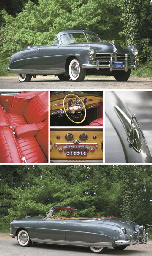Body No. B-7180 Acutely aware of the booming market in North America and the United States in particular in 1919 Rolls-Royce identified Springfield, Massachusetts as the site for its first assembly plant outside the UK. The choice of Springfield made eminent good sense at the time, when New England, and the Connecticut River valley in particular, was the center of high quality manufacturing in North America. Not only were there many nearby vendors of high quality components and services but the area around Springfield had a reservoir of skilled, meticulous craftsmen trained in the armories and machine tool factories that lined the river from Vermont to Long Island Sound. The first Springfield chassis Rolls-Royce 40/50hp Silver Ghost was delivered in 1921. Gradually specific adaptations to American conditions, preferences and suppliers worked their way into the Springfield Rolls-Royces including the somewhat revolutionary decision to offer lefthand drive in 1925. A 3-speed gearbox became standard around the same time, as did dual battery ignition. As significant as these changes were, however, none of them were as basic as the realization that Americans bought even their luxury automobiles differently from their British and Continental counterparts. Americans expected to visit a showroom, pick out a car there complete with coachwork and take it home. Rolls-Royce responded by establishing a shadow firm which bought coachwork from established coachbuilders in bulk under the name “Rolls-Royce Custom Coach Work” and supplied the catalog bodies which made up the bulk of Rolls-Royce sales in America. The recognition today, over three-quarters of a century later, of catalog names such as Pall Mall, Piccadilly, Newmarket and Ascot are ample evidence of the success of Rolls-Royce’s strategy. It also endorses the refined design and quality of construction and finishing which distinguished these and other cataloged Rolls-Royce coachwork in North America. The success of Rolls-Royce Custom Coach Work was such that in 1923 Rolls-Royce established its own coachworks in Springfield. In 1926 it took control of Brewster in Long Island City, New York and began to use the Brewster name instead of Rolls-Royce Custom Coach Work In 1927 Springfield changed over to the New Phantom, which interrupted production but improved the quality and performance of the product. At the same time Rolls-Royce introduced a series of new and up-to-date designs by Brewster which have become some of the most attractive and eagerly sought examples of classic Rolls-Royce coachwork. Designed with input from sales manager J.S. Inskip, the elegant, flowing, classic lines of the Ascot sport phaeton, the jaunty York roadster and Regent convertible coupe with their side entrance rumble seat doors and the luxurious closed Avon sedan established a precedent for quality, comfort and luxury which persists to this day in Rolls-Royce’s reputation. At some later date Rolls-Royces went through a period when they acquired a fuddy-duddy image, but this was anything but the marque’s style in the late Twenties. A November 1929 ad in Vogue magazine made it clear that performance was an essential characteristic. “Somewhere between you and the graceful little figure-head that rides that radiator, you know a powerful motor is purring. You know it by the ease with which you glide up hills, and by the swallow-flight of the scenery.” Fashionable, reliable and powerful, a Rolls-Royce had instant cachet wherever it appeared, strengthening the image of its owners and freeing them from worry about mundane matters of performance, comfort and reliability so they could concentrate on their business and social activities. Lightweight, sporting, open coachwork like the Ascot sport phaeton made the most of the Phantom I’s 7,668cc engine which some outside reports describe as having 113 brake horsepower. Not surprisingly Jay Gatsby, the protagonist in F. Scott Fitzgerald’s great novel The Great Gatsby, chos
Body No. B-7180 Acutely aware of the booming market in North America and the United States in particular in 1919 Rolls-Royce identified Springfield, Massachusetts as the site for its first assembly plant outside the UK. The choice of Springfield made eminent good sense at the time, when New England, and the Connecticut River valley in particular, was the center of high quality manufacturing in North America. Not only were there many nearby vendors of high quality components and services but the area around Springfield had a reservoir of skilled, meticulous craftsmen trained in the armories and machine tool factories that lined the river from Vermont to Long Island Sound. The first Springfield chassis Rolls-Royce 40/50hp Silver Ghost was delivered in 1921. Gradually specific adaptations to American conditions, preferences and suppliers worked their way into the Springfield Rolls-Royces including the somewhat revolutionary decision to offer lefthand drive in 1925. A 3-speed gearbox became standard around the same time, as did dual battery ignition. As significant as these changes were, however, none of them were as basic as the realization that Americans bought even their luxury automobiles differently from their British and Continental counterparts. Americans expected to visit a showroom, pick out a car there complete with coachwork and take it home. Rolls-Royce responded by establishing a shadow firm which bought coachwork from established coachbuilders in bulk under the name “Rolls-Royce Custom Coach Work” and supplied the catalog bodies which made up the bulk of Rolls-Royce sales in America. The recognition today, over three-quarters of a century later, of catalog names such as Pall Mall, Piccadilly, Newmarket and Ascot are ample evidence of the success of Rolls-Royce’s strategy. It also endorses the refined design and quality of construction and finishing which distinguished these and other cataloged Rolls-Royce coachwork in North America. The success of Rolls-Royce Custom Coach Work was such that in 1923 Rolls-Royce established its own coachworks in Springfield. In 1926 it took control of Brewster in Long Island City, New York and began to use the Brewster name instead of Rolls-Royce Custom Coach Work In 1927 Springfield changed over to the New Phantom, which interrupted production but improved the quality and performance of the product. At the same time Rolls-Royce introduced a series of new and up-to-date designs by Brewster which have become some of the most attractive and eagerly sought examples of classic Rolls-Royce coachwork. Designed with input from sales manager J.S. Inskip, the elegant, flowing, classic lines of the Ascot sport phaeton, the jaunty York roadster and Regent convertible coupe with their side entrance rumble seat doors and the luxurious closed Avon sedan established a precedent for quality, comfort and luxury which persists to this day in Rolls-Royce’s reputation. At some later date Rolls-Royces went through a period when they acquired a fuddy-duddy image, but this was anything but the marque’s style in the late Twenties. A November 1929 ad in Vogue magazine made it clear that performance was an essential characteristic. “Somewhere between you and the graceful little figure-head that rides that radiator, you know a powerful motor is purring. You know it by the ease with which you glide up hills, and by the swallow-flight of the scenery.” Fashionable, reliable and powerful, a Rolls-Royce had instant cachet wherever it appeared, strengthening the image of its owners and freeing them from worry about mundane matters of performance, comfort and reliability so they could concentrate on their business and social activities. Lightweight, sporting, open coachwork like the Ascot sport phaeton made the most of the Phantom I’s 7,668cc engine which some outside reports describe as having 113 brake horsepower. Not surprisingly Jay Gatsby, the protagonist in F. Scott Fitzgerald’s great novel The Great Gatsby, chos















Try LotSearch and its premium features for 7 days - without any costs!
Be notified automatically about new items in upcoming auctions.
Create an alert